1 RSA 2 Prime Numbers •
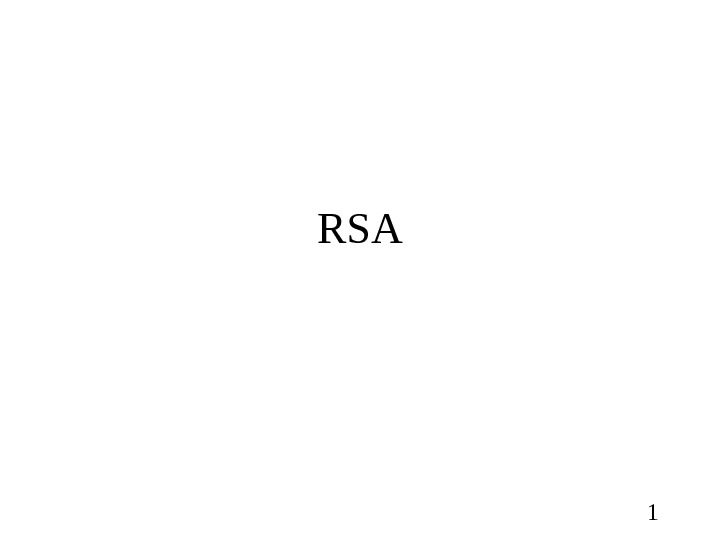

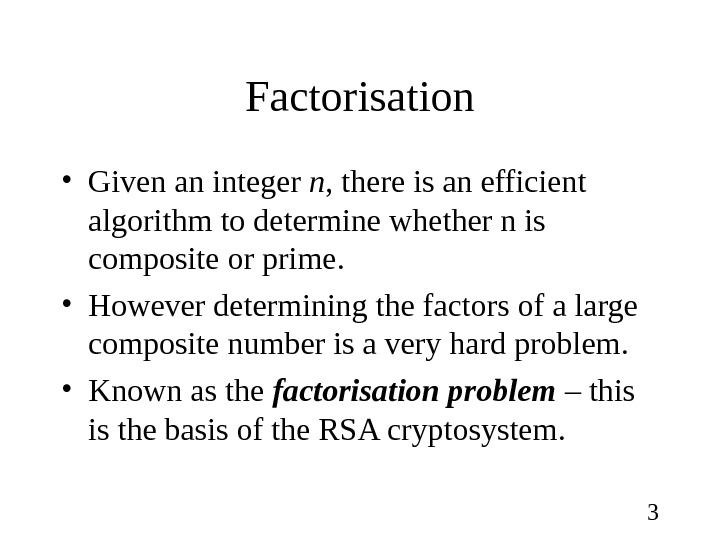




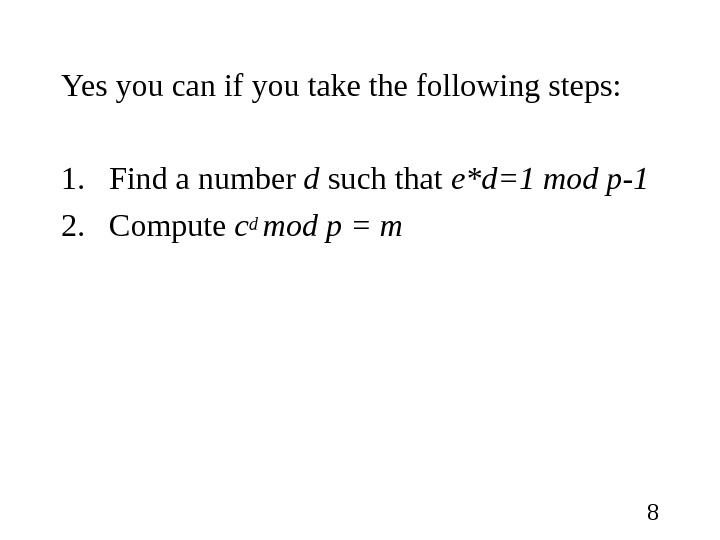
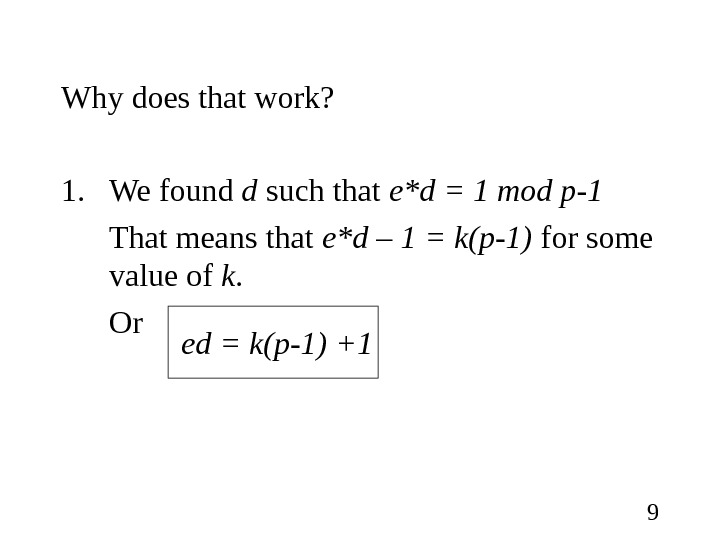

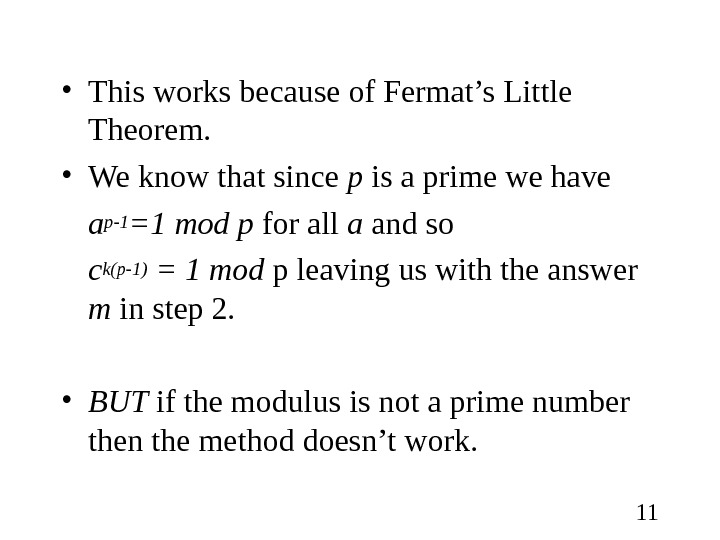



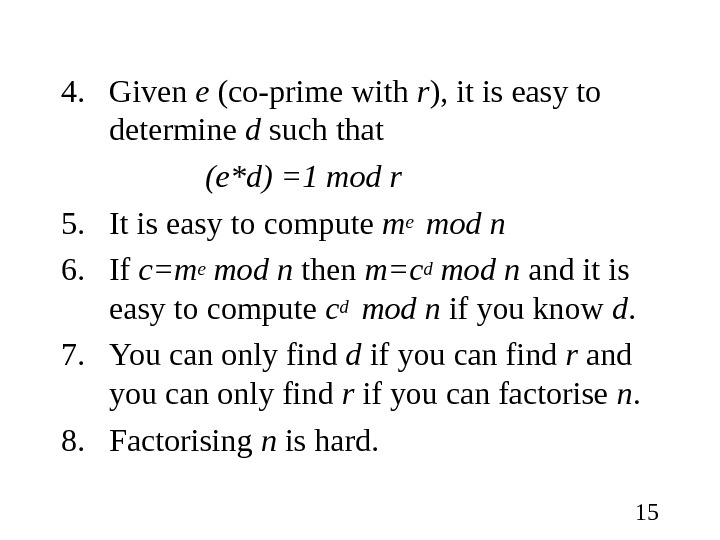
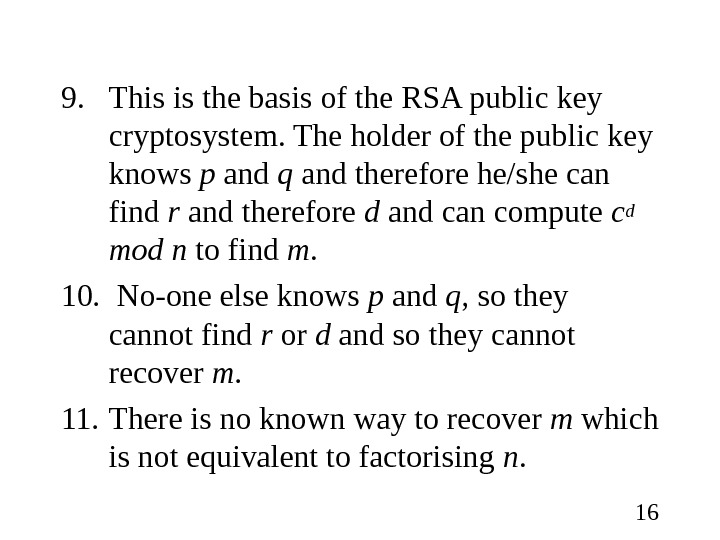


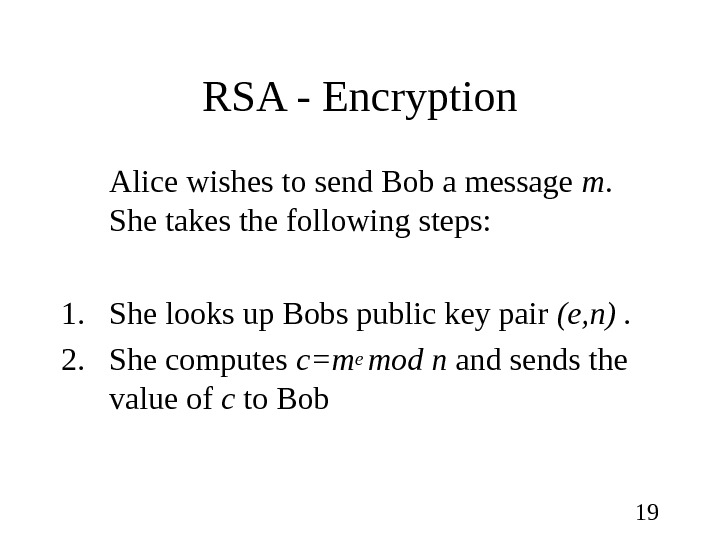

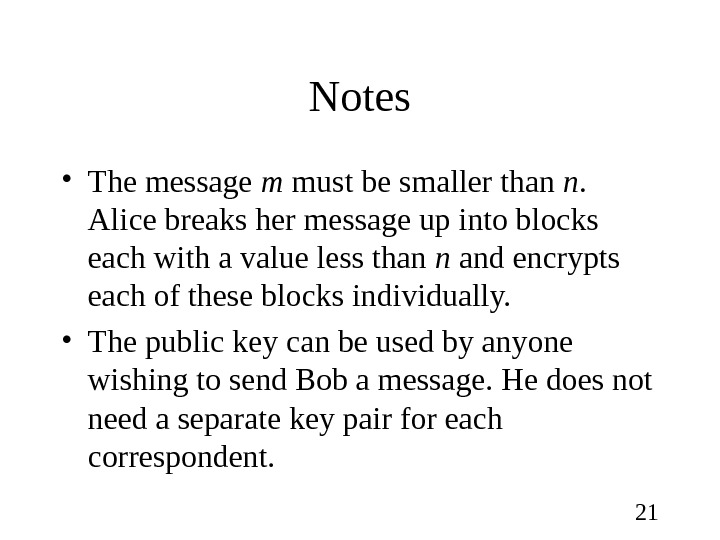
- Размер: 45 Кб
- Количество слайдов: 21
Описание презентации 1 RSA 2 Prime Numbers • по слайдам
 1 RS
1 RS
 2 Prime Numbers • An integer p is a prime number if it has no factors other than 1 and itself. • An integer which is greater than 1 and not a prime number is said to be composite. • Thus given a composite number c we know that c=r*s for some non-trivial integers r and s.
2 Prime Numbers • An integer p is a prime number if it has no factors other than 1 and itself. • An integer which is greater than 1 and not a prime number is said to be composite. • Thus given a composite number c we know that c=r*s for some non-trivial integers r and s.
 3 Factorisation • Given an integer n , there is an efficient algorithm to determine whether n is composite or prime. • However determining the factors of a large composite number is a very hard problem. • Known as the factorisation problem – this is the basis of the RSA cryptosystem.
3 Factorisation • Given an integer n , there is an efficient algorithm to determine whether n is composite or prime. • However determining the factors of a large composite number is a very hard problem. • Known as the factorisation problem – this is the basis of the RSA cryptosystem.
 4 • The fastest factorisation algorithm at the moment is called the “ Number Field Sieve” but even this is not all that efficient. • To find the factors of a composite number n which is the product of 2 large primes, and has about 640 binary bits (approximately 200 decimal digits) is an impossible task even if you could use all of the computing power in the world!
4 • The fastest factorisation algorithm at the moment is called the “ Number Field Sieve” but even this is not all that efficient. • To find the factors of a composite number n which is the product of 2 large primes, and has about 640 binary bits (approximately 200 decimal digits) is an impossible task even if you could use all of the computing power in the world!
 5 Important to Note: 1. Determining whether a large number is prime or composite is easy; 2. Multiplying 2 large numbers together is easy; 3. Factorising a large number which is the product of 2 large primes (i. e. retrieving the original prime factors) is very difficult.
5 Important to Note: 1. Determining whether a large number is prime or composite is easy; 2. Multiplying 2 large numbers together is easy; 3. Factorising a large number which is the product of 2 large primes (i. e. retrieving the original prime factors) is very difficult.
 6 Fermat’s Little Theorem If p is a prime number and a is any number between 1 and p-1 inclusive, then a p-1 mod p = 1 This is not true in general, which gives us a method to decide if a given number n is prime or composite.
6 Fermat’s Little Theorem If p is a prime number and a is any number between 1 and p-1 inclusive, then a p-1 mod p = 1 This is not true in general, which gives us a method to decide if a given number n is prime or composite.
 7 Solving a problem Suppose I have • a prime number p ; • a number m between 1 and p-1 inclusive; • another number e also between 1 and p-1 ; And I compute • c = m e mod p If I give you c, e and p can you find m?
7 Solving a problem Suppose I have • a prime number p ; • a number m between 1 and p-1 inclusive; • another number e also between 1 and p-1 ; And I compute • c = m e mod p If I give you c, e and p can you find m?
 8 Yes you can if you take the following steps: 1. Find a number d such that e*d=1 mod p-1 2. Compute cd mod p = m
8 Yes you can if you take the following steps: 1. Find a number d such that e*d=1 mod p-1 2. Compute cd mod p = m
 9 Why does that work? 1. We found d such that e*d = 1 mod p-1 That means that e*d – 1 = k(p-1) for some value of k. Or ed = k(p-1) +
9 Why does that work? 1. We found d such that e*d = 1 mod p-1 That means that e*d – 1 = k(p-1) for some value of k. Or ed = k(p-1) +
 102. We computed cd mod p But c d = (me )d mod p = m ed mod p = m k(p-1) +1 mod p = m k(p-1) * m mod p = 1*m mod p = m mod p
102. We computed cd mod p But c d = (me )d mod p = m ed mod p = m k(p-1) +1 mod p = m k(p-1) * m mod p = 1*m mod p = m mod p
 11 • This works because of Fermat’s Little Theorem. • We know that since p is a prime we have ap-1 =1 mod p for all a and so c k(p-1) = 1 mod p leaving us with the answer m in step 2. • BUT if the modulus is not a prime number then the method doesn’t work.
11 • This works because of Fermat’s Little Theorem. • We know that since p is a prime we have ap-1 =1 mod p for all a and so c k(p-1) = 1 mod p leaving us with the answer m in step 2. • BUT if the modulus is not a prime number then the method doesn’t work.
 12 Why doesn’t it work? • In general a n-1 1 mod n if n is not prime. • We could make the method for finding m work if we knew the number r such that a r = 1 mod n If a and n are co-prime then there will be such a number r and there is a way to find it
12 Why doesn’t it work? • In general a n-1 1 mod n if n is not prime. • We could make the method for finding m work if we knew the number r such that a r = 1 mod n If a and n are co-prime then there will be such a number r and there is a way to find it
 13 Finding r • In order to find r such that ar = 1 mod n , you have to be able to factorise n and find all of its prime factors. • If n = p*q where p and q are primes then r = (p-1)*(q-1)
13 Finding r • In order to find r such that ar = 1 mod n , you have to be able to factorise n and find all of its prime factors. • If n = p*q where p and q are primes then r = (p-1)*(q-1)
 14 Important to note now: 1. It is easy to determine whether a large number is prime or composite. 2. It is easy to compute the product of two large primes n = p*q. 3. Setting r = (p-1)*(q-1) we have mr = 1 mod n for all m co-prime with n.
14 Important to note now: 1. It is easy to determine whether a large number is prime or composite. 2. It is easy to compute the product of two large primes n = p*q. 3. Setting r = (p-1)*(q-1) we have mr = 1 mod n for all m co-prime with n.
 154. Given e (co-prime with r ), it is easy to determine d such that (e*d) =1 mod r 5. It is easy to compute me mod n 6. If c=m e mod n then m=cd mod n and it is easy to compute c d mod n if you know d. 7. You can only find d if you can find r and you can only find r if you can factorise n. 8. Factorising n is hard.
154. Given e (co-prime with r ), it is easy to determine d such that (e*d) =1 mod r 5. It is easy to compute me mod n 6. If c=m e mod n then m=cd mod n and it is easy to compute c d mod n if you know d. 7. You can only find d if you can find r and you can only find r if you can factorise n. 8. Factorising n is hard.
 169. This is the basis of the RSA public key cryptosystem. The holder of the public key knows p and q and therefore he/she can find r and therefore d and can compute c d mod n to find m. 10. No-one else knows p and q , so they cannot find r or d and so they cannot recover m. 11. There is no known way to recover m which is not equivalent to factorising n.
169. This is the basis of the RSA public key cryptosystem. The holder of the public key knows p and q and therefore he/she can find r and therefore d and can compute c d mod n to find m. 10. No-one else knows p and q , so they cannot find r or d and so they cannot recover m. 11. There is no known way to recover m which is not equivalent to factorising n.
 17 RSA – Key Generation 1. Bob generates two large primes p and q (each with approx. 100 decimal digits). 2. He computes n = p*q 3. He computes r = (p-1)*(q-1) 4. He chooses a random number e which is between 1 and r which has no factor in common with r.
17 RSA – Key Generation 1. Bob generates two large primes p and q (each with approx. 100 decimal digits). 2. He computes n = p*q 3. He computes r = (p-1)*(q-1) 4. He chooses a random number e which is between 1 and r which has no factor in common with r.
 185. He computes the private key d by solving the equation (e*d) =1 mod r. 6. He can now carefully dispose of the values of p, q and r. 7. Bob keeps d private but publishes the value of the pair (e, n). This is his public key.
185. He computes the private key d by solving the equation (e*d) =1 mod r. 6. He can now carefully dispose of the values of p, q and r. 7. Bob keeps d private but publishes the value of the pair (e, n). This is his public key.
 19 RSA — Encryption Alice wishes to send Bob a message m. She takes the following steps: 1. She looks up Bobs public key pair (e, n). 2. She computes c=me mod n and sends the value of c to Bob
19 RSA — Encryption Alice wishes to send Bob a message m. She takes the following steps: 1. She looks up Bobs public key pair (e, n). 2. She computes c=me mod n and sends the value of c to Bob
 20 RSA — Decryption Bob receives the value c from Alice. He decrypts it using his private key d by computing m=cd mod n
20 RSA — Decryption Bob receives the value c from Alice. He decrypts it using his private key d by computing m=cd mod n
 21 Notes • The message m must be smaller than n. Alice breaks her message up into blocks each with a value less than n and encrypts each of these blocks individually. • The public key can be used by anyone wishing to send Bob a message. He does not need a separate key pair for each correspondent.
21 Notes • The message m must be smaller than n. Alice breaks her message up into blocks each with a value less than n and encrypts each of these blocks individually. • The public key can be used by anyone wishing to send Bob a message. He does not need a separate key pair for each correspondent.
